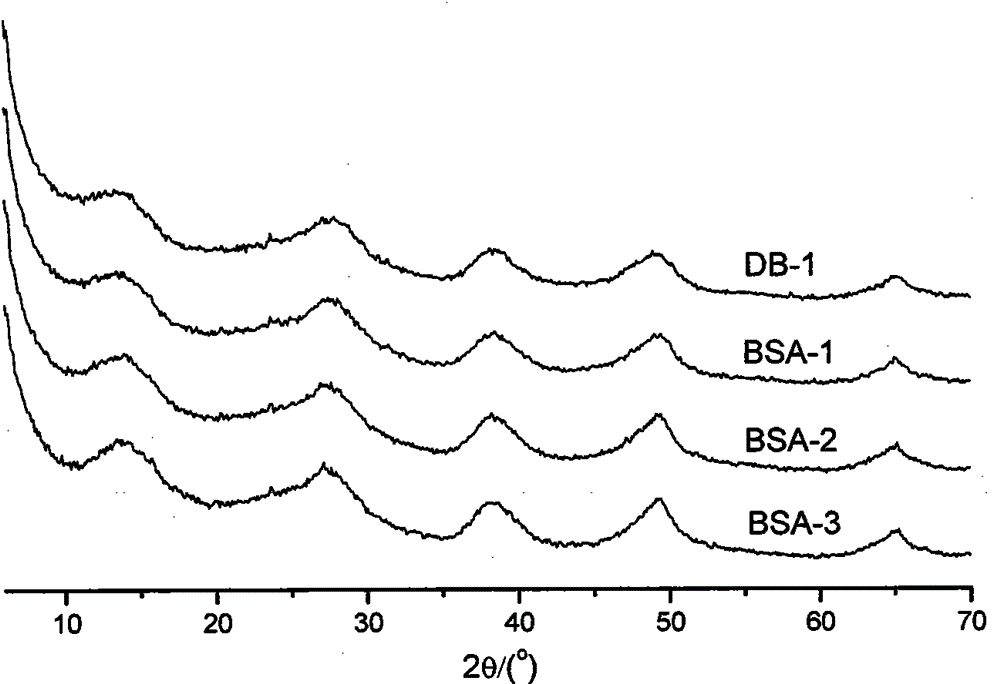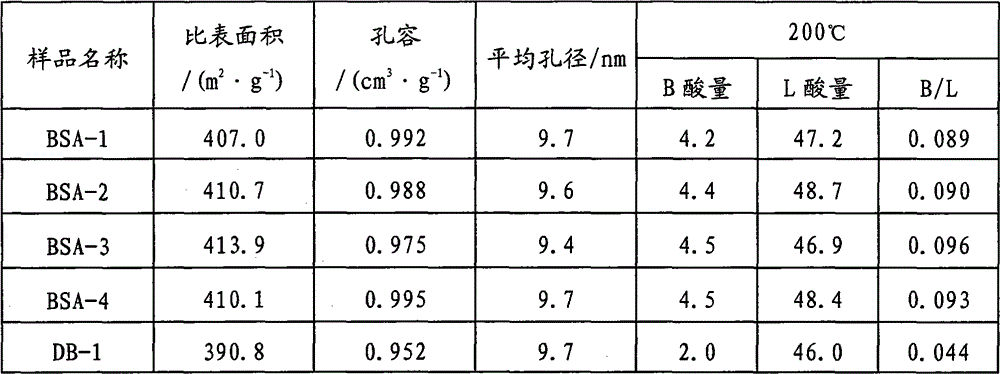A kind of silica-alumina catalytic material with pseudo-boehmite crystal phase structure
A catalytic material, pseudo-boehmite technology, applied in catalytic cracking, physical/chemical process catalyst, metal/metal oxide/metal hydroxide catalyst, etc., can solve the problem of low impurity content, uneven distribution of silicon and aluminum, The problems of high price and stability of silicones can achieve the effect of obvious pore characteristics, good light oil and slight reactivity, and high crystallinity.
- Summary
- Abstract
- Description
- Claims
- Application Information
AI Technical Summary
Problems solved by technology
Method used
Image
Examples
Embodiment 1
[0019] This example illustrates the preparation of the acidic silica-alumina catalytic material provided by the invention.
[0020] The preparation process of this embodiment is the same as that described in CN1565733A. Take an appropriate concentration of 90gAl 2 o 3 / L Al 2 (SO 4 ) 3The solution is placed in a beaker, and ammonia water is added dropwise under stirring conditions until the system pH = 8, and the neutralization and gelling temperature is 55°C; under stirring conditions, add a quantitative concentration of 60gSiO 2 / L of water glass, heated to 80°C for 2 hours; use NH 4 Cl solution according to precipitate (dry basis): ammonium salt: H 2 O = 1: 0.8: 10 weight ratio, at 60 ° C, carry out ion exchange on the silica-alumina precipitate to remove sodium ions, repeat the exchange twice, each time for 0.5 hours, and then re-beat the obtained filter cake and press fluoro-silicon Acid: Material dry basis: H 2 The weight ratio of O=0.02:1:10, the required fluosi...
Embodiment 2
[0026] This example illustrates the preparation of the acidic silica-alumina catalytic material provided by the invention.
[0027] The preparation process is the same as in Example 1, wherein the addition ratio of fluosilicic acid is fluosilicic acid: material dry basis: H 2 O=0.05:1:10, the acidic silica-alumina catalyst material can be obtained after washing and drying. Recorded as BSA-2.
[0028] The X-ray diffraction spectrum of BSA-2 is shown in figure 1 Middle; crystallinity and elemental analysis chemical composition are listed in Table 1; pore parameters such as specific surface area and infrared acidity data are listed in Table 2.
Embodiment 3
[0030] This example illustrates the preparation of the acidic silica-alumina catalytic material provided by the invention.
[0031] The preparation process is the same as in Example 1, wherein the addition ratio of fluosilicic acid is fluosilicic acid: material dry basis: H 2 O=0.08:1:10, the acidic silica-alumina catalyst material can be obtained after washing and drying. Recorded as BSA-3.
[0032] The X-ray diffraction spectrum of BSA-3 is shown in figure 1 Middle; crystallinity and elemental analysis chemical composition are listed in Table 1; pore parameters such as specific surface area and infrared acidity data are listed in Table 2.
PUM
| Property | Measurement | Unit |
|---|---|---|
| specific surface area | aaaaa | aaaaa |
| pore size | aaaaa | aaaaa |
| specific surface area | aaaaa | aaaaa |
Abstract
Description
Claims
Application Information
 Login to View More
Login to View More - R&D
- Intellectual Property
- Life Sciences
- Materials
- Tech Scout
- Unparalleled Data Quality
- Higher Quality Content
- 60% Fewer Hallucinations
Browse by: Latest US Patents, China's latest patents, Technical Efficacy Thesaurus, Application Domain, Technology Topic, Popular Technical Reports.
© 2025 PatSnap. All rights reserved.Legal|Privacy policy|Modern Slavery Act Transparency Statement|Sitemap|About US| Contact US: help@patsnap.com



